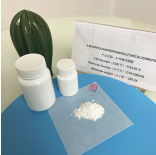Chinese VersionChina Suppliers > Hubei new DE sheng material science and technology co., LTD. > Buffer Range and Application of MOPS Buffer
- Search Product
-
-
- Region :China/Hubei
- Tel : +86-18971041571
- Fax :
- Email :vickyzhao@whdschem.com
- URL :
- Add :Guanggu United Science and Technology City C8, Ezhou City, Hubei Province
- Details for Buffer Range and Application of MOPS Buffer
-
Buffer Range and Application of MOPS Buffer
Category : Other Chemicals/Others

CAS NO : 1132-61-2 EC NO : 214-478-5 MF : C7H15NO4S MW : 209.2633 Specification : White Powder Packing : 500g/bottle Product description : MOPS (3- (N-morpholine) propionic acid) is a commonly used biochemical buffer, widely used in the fields of molecular biology, cell biology, and biochemistry. Its unique performance makes it an ideal buffer choice in many experiments. What is its buffer range? In what areas can it be applied? Buffer range of MOPS buffer MOPS is an effective buffer, with a buffer range generally between pH 6.5 and 7.9. Within this range, MOPS can stably maintain the acid-base balance of the solution and avoid drastic fluctuations in pH value. Its pKa value is 7.14, which makes MOPS have good buffering performance under neutral and weakly alkaline conditions, which can provide a stable experimental environment in many biochemical experiments. application area 1. Protein electrophoresis: MOPS buffer is widely used in protein SDS-PAGE electrophoresis. In this application, MOPS can effectively maintain the stability of the electrophoresis buffer, ensure the migration effect of protein samples, and provide a constant pH environment to ensure the accuracy of the experiment. 2. Nucleic acid electrophoresis: MOPS can also be used for nucleic acid electrophoresis, such as agarose gel electrophoresis. MOPS can maintain an appropriate pH value to optimize the migration efficiency of nucleic acid molecules. 3. Membrane protein research: Due to the stability of MOPS buffer under neutral to alkaline conditions, MOPS is often chosen as a buffer when studying the structure and function of membrane proteins. It can conduct experiments while maintaining the natural state of proteins, ensuring the reliability of experimental results. 4. Cell culture: MOPS buffer is also commonly used in cell culture to regulate the acid-base balance of the culture medium and provide a suitable growth environment for cells. Its pH value makes it an ideal choice for cell culture. In summary, MOPS buffer has a wide range of applications in biochemical experiments, with excellent performance in the buffer range of pH 6.5-7.9, suitable for protein electrophoresis, nucleic acid electrophoresis, membrane protein research, and cell culture. Researchers can choose appropriate MOPS buffer conditions based on experimental requirements during experimental design to obtain stable and reliable experimental results. Desheng is one of the suppliers of biological buffer raw materials. It not only has rich experience and professional knowledge in the field of biochemistry, but also has won high recognition from customers with its high-quality products and excellent services. Its products have undergone strict quality control, ensuring stable chemical properties and excellent performance. If you have any interest, please feel free to contact us for purchase! Uses : Biological buffer Synonyms : 3-(4-Morpholino)propanesulphonic acid;3-(N-Morpholino)propanesulfonic acid;3-N-morpholinopropansulfonic acid;MOPS;MOPS, CONCENTRATE SOLUTION;MORPHOLINOPROPANE SULFONIC ACID;TIMTEC-BB SBB009133;LABOTEST-BB LT00455082;LABOTEST-BB LT01595956;4-MORPHOLINEPROPANESULFONIC ACID;4-(MORPHOLINOPROPANE SULFONIC ACID);3-(morpholin-4-yl)propane-1-sulfonic acid;3-(4-Morpholino)propane sulfonic acid;3-MorpholinopropanesuIfonic Acid; Molecular Structure : 
- more>>Other Products
-
- • Biological buffer 3- [N, N-di (hydroxyethyl) amino] -2-hydroxypropanesulfonic acid DIPSO
- • Luminol Sodium Salt
- • 4-Aminophthalhydrazide
- • acridinium ester DMAE-NHS
- • acridinium ester NSP-DMAE-NHS
- • Acridine hydrochloride NSP-SA
- • Acridine hydrochloride NSP-SA-NHS
- • NSP-SA-ADH
- • acridinium ester ME-DMAE-NHS TOOS; 3-(N-Ethyl-3-Methylanilino)-2-Hydroxypropanesulfonic Acid Sodium Salt
- • TOPS; Sodium 3-(N-Ethyl-3-Methylanilino)Propanesulfonate; N-Ethyl-N-Sulfopropyl-M-Toluidine Sodium Salt
- • ADOS Sodium 3-(Ethyl(3-Methoxyphenyl)Amino)-2-Hydroxypropane-1-Sulfonate Dihydrate
- • ADPS N-Ethyl-N-(3-Sulfopropyl)-3-Methoxyaniline Sodium Salt
- • ALPS N-Ethyl-N-(3-Sulfopropyl)Aniline Sodium Salt; Sodium 3-(Ethyl(Phenyl)Amino)Propane-1-Sulfonate; Sodium
- • DAOS; Sodium 3-((3,5-Dimethoxyphenyl)(Ethyl)Amino)-2-Hydroxypropane-1-Sulfonate
- • HDAOS; N-(2-Hydroxy-3-Sulfopropyl)-3,5-Dimethoxyaniline Sodium Salt
- • MADB N,N-Bis(4-Sulfobutyl)-3,5-Dimethylaniline Disodium Salt
- • MAOS N-Ethyl-N-(2-Hydroxy-3-Sulfopropyl)-3,5-Dimethylaniline Sodium Salt Monohydrate
- • DAB 3,3',4,4'-Biphenyltetramine Tetrahydrochloride